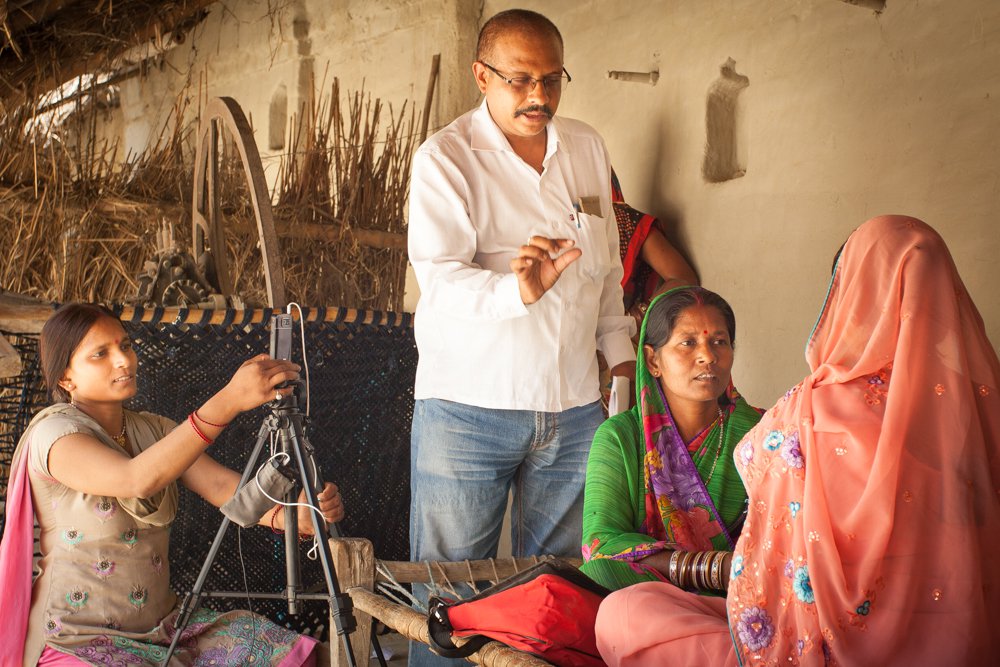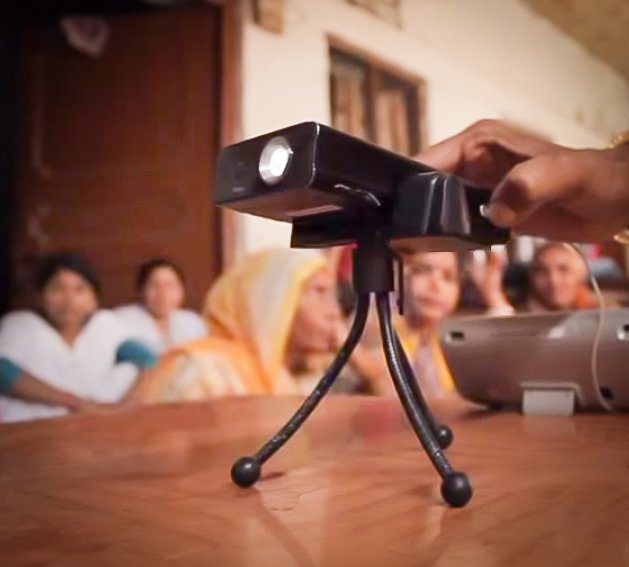The Projecting Health project empowers communities to use inexpensive video gear to create and screen locally made health education videos. Video: PATH.
Suman Patel is beaming. You can see her pride in the pleasure of her smile and her eagerness to talk about her latest efforts as a community health worker in rural India. She’s succeeding at one of the biggest challenges in community health—getting people to change their habits in favor of healthier behaviors.
Her secret? Amateur actors, simple video production equipment, a low-cost portable projector, and a white sheet. She’s a part of PATH’s Projecting Health project, empowering local communities with the skills and digital tools to create health education videos customized for local contexts, customs, and dialects. In the process, she’s part of an innovative shift—made possible by recent advances in digital technology—that empowers neighbors and peers to be onscreen messengers encouraging behavior change in their communities.

The Projecting Health project empowers communities to make locally appropriate, technically accurate health education videos. Photo: PATH/Branded Filmz.
The power of peer persuasion
Until about a year ago, Suman tried to influence pregnant women in her mothers’ groups through talks and games. Her visual tools were limited to posters and flip charts. While she had some success, she knew her toolkit was often not compelling enough to convince all of the women to change key behaviors.

The increasing availability of inexpensive video technology makes the Projecting Health project possible even in rural communities. Photo: PATH/Branded Filmz.
Now she and other community health workers collaborate with village women to identify pressing health topics and train them to produce, act in, and edit videos that address local barriers to change. Enlisting local women to star in the videos is a key element, says Suman, because “people trust them.”
Fortunately, “there is no shortage of people who want to act in the videos,” says Kiersten Israel-Ballard, director of the Projecting Health project, who adds, “I’ve never worked on a project that was quite so community-driven.”
The women watch the videos in mothers’ groups and at village health and nutrition days. Seeing the topic played out on the screen (typically a sheet draped on a wall) by people they identify with leads to a more enriching discussion and sharing of experiences. If the women don’t understand something, they replay the video and discuss it until they do.

Women watch the Projecting Health videos in facilitated groups and discuss what they are learning. Photo: PATH/Branded Filmz.
Revolutionizing behavior change
Based on the project’s success in India, PATH and our partners plan to expand the Projecting Health model to countries in Africa and to other health topics, such as immunization, family planning, and adolescent health for girls. Says Dr. Ballard, “We feel it’s a method that can completely revolutionize behavior change across health topics.”
She and her team are particularly enthusiastic about how quickly the project is reaching a wider audience. So far, 35 videos have been made on such topics as breastfeeding, immunization, and preparing for childbirth. They’ve been screened locally more than 4,200 times and been played well over 40,000 times on YouTube.

Many of the videos are funny and engaging while delivering serious messages.
That the videos are accessed that often on YouTube is fantastic, but even more exciting is that women have taken the next step on their own. “We knew we wanted to take this mobile,” says Dr. Ballard, “but unbeknownst to us, the community had already figured out how to download the videos onto their cell phones. Women are showing the videos to their husbands and mothers-in-law and friends. The potential reach is huge.”
Early findings from a project evaluation make clear that all that viewing is having an impact on maternal and newborn care practices. Women who took part in Projecting Health showed significant improvements in their knowledge and behaviors around such critical activities as preparing for childbirth, breastfeeding, and preventing umbilical cord infections.
Suman can testify to the results: “When I used to visit a village and share health information, they would listen, but not put it into practice. Now when they see the films they understand. Now everyone practices what they see in the videos.”
